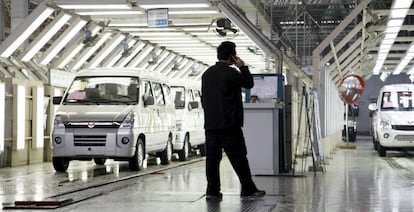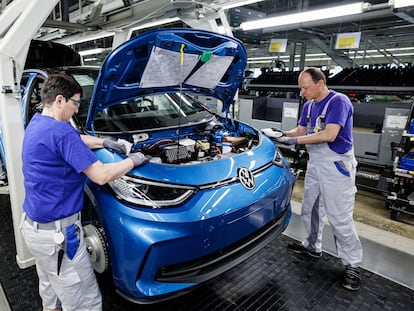Europe goes on the defensive against tide of Chinese electric vehicles
The EU has opened an investigation into export aid as Asian brands oust local rivals

Almost unknown among the general public, the names SAIC, Geely, BYD, and Great Wall Motors strike fear into the hearts of European automobile industry giants. They are seen as the vanguard of a massive wave of Chinese-made cars (especially electric vehicles) entering the European market. The Asian giant has already taken the lead, driven by advances in its immense local market, in which 5.4 million units were sold last year. MG, Volvo, Polestar, and BYD itself are just a handful of the makes with which these large groups have headed to the Old Continent, which a few weeks ago led the president of the European Commission, Ursula von der Leyen, to speak out and announce an investigation into the alleged public aid received by these companies to facilitate their entry into the community market: a clear sign of economic dumping. The announcement became a reality at the beginning of the month with a resolution stating that “the Commission has gathered sufficient evidence that producers of the investigated product [electric cars] in the People’s Republic of China have benefited from various subsidies granted by the government of that country.”
Its weight in the European market as a whole is still low (2.8% in the first seven months of the year), according to Schmidt Automotive Research. But the market share of Chinese manufacturers has increased to 8.2% in the electric vehicles sector alone, often seen as the future of the automotive industry on a continent that wants to phase out sales of combustion vehicles by 2035. As Schmidt highlighted in one of his latest reports: in electric cars, the MG reborn in the hands of SAIC has positioned itself ahead of leading European brands such as Peugeot, Renault, and Skoda in 2023. The Asian industry has managed to manufacture high-tech vehicles at a competitive price for Europeans, and at the same time has secured a value chain (including sourcing raw materials) that gives them a competitive advantage over their rivals. A European manager who knows the automotive industry in Europe and China sums it up: “The Chinese cars are not competitive because they receive aid, but because they are three or five years more advanced than the European ones and that allows them to manufacture cheaper cars.”
A professor at the IESE business school, Pedro Nueno is the honorary president of the China Europe International Business School and an expert on the Chinese automotive industry. He explains: “Europeans and Americans saw an opportunity in China and went to manufacture there, and now it is logical that the Chinese also want to go out into the world to sell.” He is referring to the arrival of the foreign market in the 1980s, which would expand from 1994, when the Asian giant opened its market and its factories to the European and American automotive industry on the condition that they formed 50/50 alliances with local partners. That operation allowed foreign brands to take over sales leadership, with 70% of registrations in 2010.
In the 2000s, the Chinese government realized the potential of electric cars as a platform to place its industry at the forefront of auto manufacturing and also end the country’s dependence on oil. Consequently, different plans were launched to promote the use of electric vehicles. These aimed to manufacture three million electric cars in 2025 to gain a 20% market share. But that objective was achieved in 2022, like all the previous plans that had been making progress towards their objectives. Meanwhile, in Europe, the registration of fully electric vehicles was barely 12%. “They want to have the largest market to be able to invest more in product development and supply,” says Nueno, “and they have managed to create decent models at reasonable prices, and if you have a good product, that product is global: It is logical that they want to enter Europe.”
According to Manuel Kallweit, an economist for the powerful German vehicle manufacturers’ association, “currently, China has a competitive advantage when it comes to raw materials. They also started building the infrastructure needed to manufacture batteries [before the Europeans].” And he adds: “Along with commitment from the industry, we need the political framework that allows us to be leaders in this area. That is, we need more trade agreements, less bureaucracy, and a better situation for energy prices.”
But the executive branch of the EU believes that it is not just a matter of commitments or innovation, and focuses on subsidies: “Among other things, the [Chinese] practices consist of: 1) direct transfers of funds and potential direct transfers of funds or obligations; 2) the forgiveness or non-collection of public revenues; and 3) the public supply of goods and services in exchange for less than adequate remuneration,” according to the resolution opening the investigation. Brussels asserts that this would have given rise to a production capacity in China that its market — the largest in the world — does not “seem to be able to absorb” in the future. In turn, this “indicates the probability of a substantial increase in subsidized imports and the consequent damage” to the EU industry.
The investigation may last for 13 months, but after nine months the first measures could be imposed. It is not clear that this will be effective, according to Alicia García-Herrero, an Asia-Pacific expert at the Brussels think tank Bruegel. Like most of the experts, she believes that Europe already has tools such as the carbon border adjustment mechanism (CBAM), through which the EU can apply taxes to goods arriving in the internal market if they have been produced with lower emission standards than those required in Europe. “Chinese manufacturing uses dirty energy: 70% of the energy consumed comes from coal,” she points out.
Europe, the last step in Chinese expansion
China’s manufacturers first made a name for themselves in the emerging economies of Asia, the Middle East, and Latin America, but the industry has been preparing to attack the Old Continent, which is more demanding and also more profitable. Today that market represents 28% of Chinese exports, three and a half times more in just six years. A report from Allianz Research warns that the automotive trade balance in Europe entered negative territory for the first time last December. In Germany, the main European market, three of the ten best-selling electric vehicles were fully or partially imported from China.
In May, the research service of the German insurance group carried out an economics exercise to find out what would happen to European manufacturers if Asian brands captured 75% of the Chinese market and 10% of the European market in 2030. Their conclusions support the fear among the European automakers, which would lose 1.7 million cars in China (37%) and annual profits of €7 billion ($7.44 billion). And in Europe, the arrival of Chinese-made cars would mean losing 1.5 million vehicles, 13% of production in the 27-state bloc. In summary, 0.15% of the EU’s GDP would be lost, around €24.2 billion ($25.7 billion). There is no reference to the risk for employment, although the impact is evident.
Despite this, Kallweit believes that it is too early to rule on the investigation opened by Brussels and says: “The German automobile industry has a high market share in China and it is normal for companies from other parts of the world to try to enter the [European] market.”
Amadeu Jansana, director of studies at Casa Asia, puts the investigation more in the political than the economic sphere. Warning of the risks, he points out: “On this issue there is a difference of opinion between France and Germany, and the Commission president’s proposal seems to reflect the interests of French manufacturers, because the Germans have more interests in China. You can take measures to protect yourself from Asian manufacturers, but that has its risks, because China can also retaliate,” he says. In his opinion, if the development of electric cars in China is ahead with respect to Tesla, it is because the Chinese started earlier and committed more.
Sign up for our weekly newsletter to get more English-language news coverage from EL PAÍS USA Edition
Tu suscripción se está usando en otro dispositivo
¿Quieres añadir otro usuario a tu suscripción?
Si continúas leyendo en este dispositivo, no se podrá leer en el otro.
FlechaTu suscripción se está usando en otro dispositivo y solo puedes acceder a EL PAÍS desde un dispositivo a la vez.
Si quieres compartir tu cuenta, cambia tu suscripción a la modalidad Premium, así podrás añadir otro usuario. Cada uno accederá con su propia cuenta de email, lo que os permitirá personalizar vuestra experiencia en EL PAÍS.
¿Tienes una suscripción de empresa? Accede aquí para contratar más cuentas.
En el caso de no saber quién está usando tu cuenta, te recomendamos cambiar tu contraseña aquí.
Si decides continuar compartiendo tu cuenta, este mensaje se mostrará en tu dispositivo y en el de la otra persona que está usando tu cuenta de forma indefinida, afectando a tu experiencia de lectura. Puedes consultar aquí los términos y condiciones de la suscripción digital.
More information
Archived In
Últimas noticias
Welcome to the post-religion era: The idea of Christianity as the absolute truth has become obsolete
‘I thought you would like it’: The risky sexual practice popularized by TV shows and TikTok
The digitalization of tourism: ‘They promise experiences and gave us the worst possible one’
Mexican peso defies uncertainty with forecasts of a new period of stability in 2026
Most viewed
- Sinaloa Cartel war is taking its toll on Los Chapitos
- Oona Chaplin: ‘I told James Cameron that I was living in a treehouse and starting a permaculture project with a friend’
- Reinhard Genzel, Nobel laureate in physics: ‘One-minute videos will never give you the truth’
- Why the price of coffee has skyrocketed: from Brazilian plantations to specialty coffee houses
- Silver prices are going crazy: This is what’s fueling the rally










































